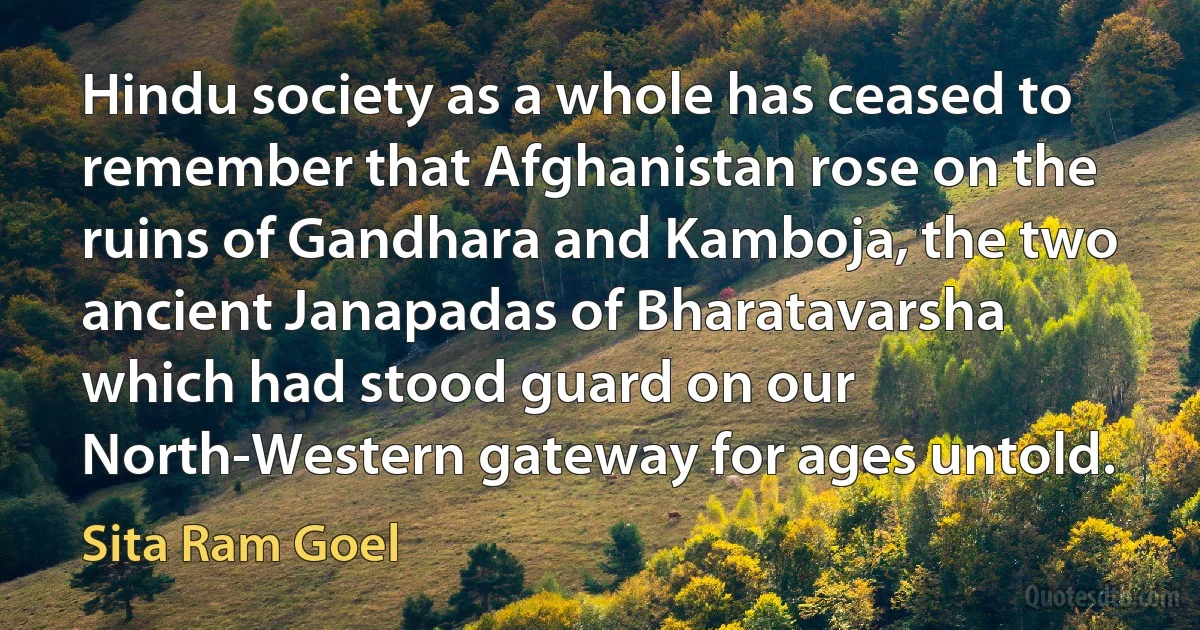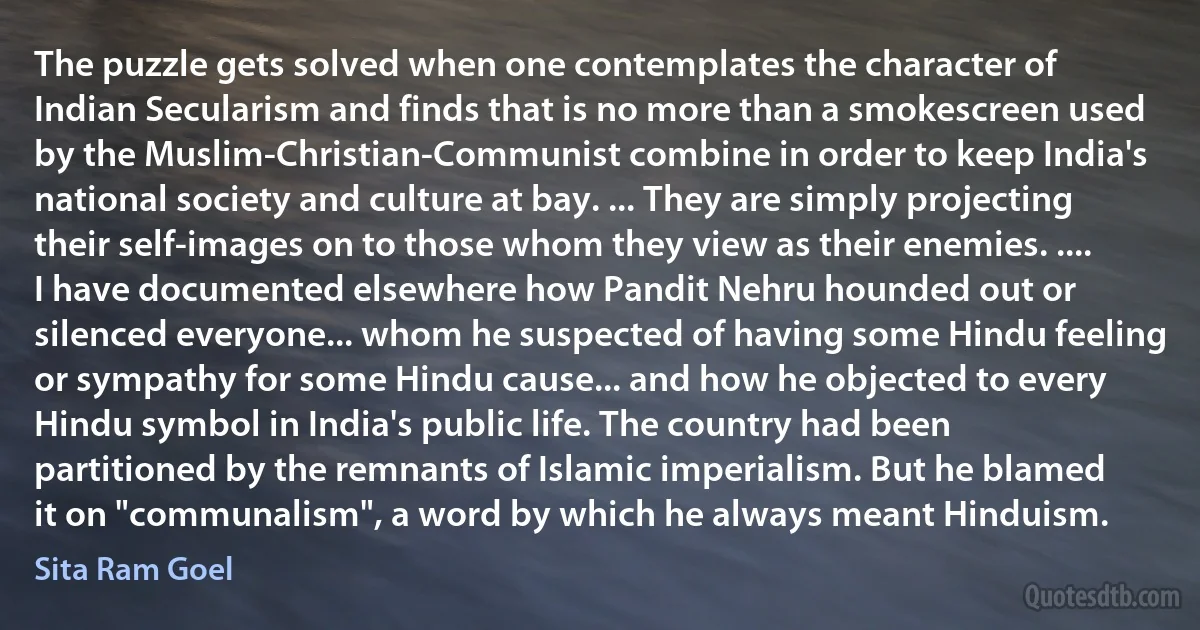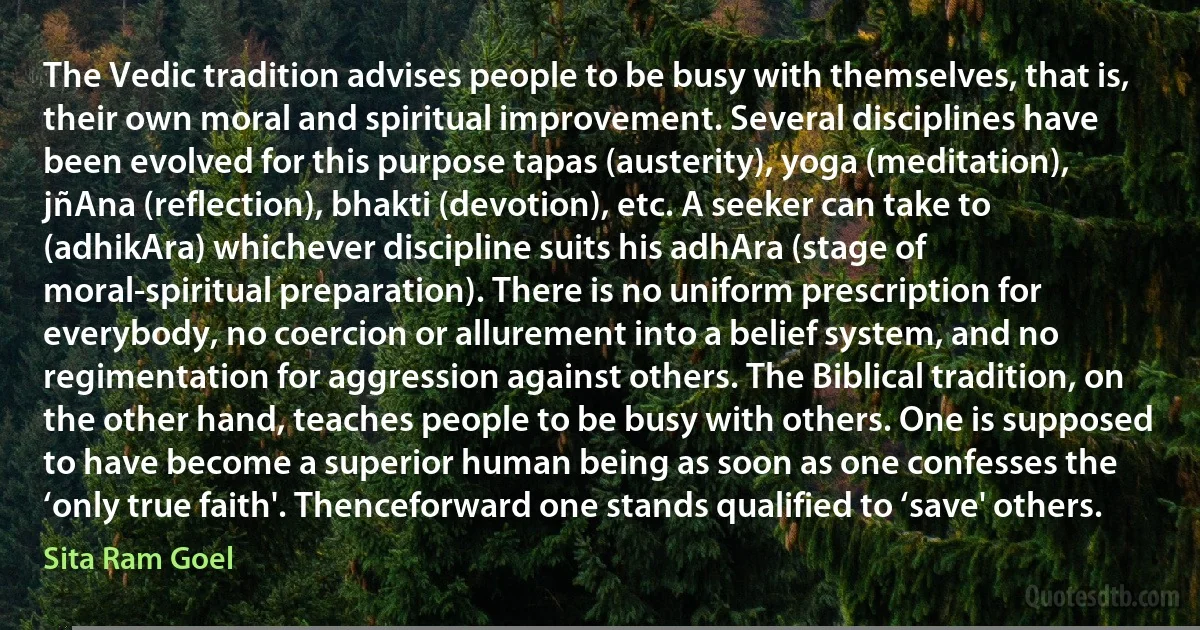Sita Ram Goel quotes - page 3
The 16 August, 1946 communal riots broke out in Calcutta after a few days. I would have been killed by a Muslim mob in the early hours of that day as I walked back towards my home from the coffee house which I had found closed. My fluent Urdu and my Western dress saved me. My wife and two year old son had joined me a few days earlier in a small room in a big house bordering on a large Muslim locality. On the evening of the 17th we had to vacate that house and scale a wall at the back to escape murderous Muslim mobs advancing with firearms. Had not the army moved in immediately after, I would not have lived to write what I am writing today.

Sita Ram Goel
There is plenty of primary literature available in Arabic and Persian regarding the rise, development, and doings of numerous sufi silsilas in India. Some of this literature has been translated into Urdu and English as well. A study of this literature leaves little doubt that sufis were the most fanatic and fundamentalist elements in the Islamic establishment in medieval times. Hindus should go to this literature rather than fall for latter-day Islamic propaganda. The ruin of Hindus and Hinduism in Kashmir in particular, can be safely credited to sufis who functioned there from the early thirteenth century onwards.

Sita Ram Goel
Islamism immediately revived the lost cause of Urdu behind the smoke-screen of this Communist campaign against Hindi. It lauded loudly when progressive Urdu poets like Firaq Gorakhpuri lampooned Hindi in a language which was largely unprintable. Simultaneously, Islamism started parading Urdu as the great language of culture and refinement which will be lost to India for good if Urdu was allowed to go under. No Communist came forward to examine this "culture and refinement as a legacy of decadent Muslim courts and a frivolous Muslim aristocracy. No Communist questioned the heavy Persianisation and Arabicisation of Urdu which made it incomprehensible even to educated people, leave alone the man in Chandni Chowk. The recognition of Urdu as a second language has today become a sine qua non of Secularism.

Sita Ram Goel
The national leadership could have avoided this calamitous course by going to the sources of Muslim separatism and by identifying the spearheads of this separatism as residues of Islamic imperialism rather than as leaders of a bonafide minority. That needed a historical perspective which the national leadership either did not possess, or did not entertain when it was presented to it by the more perspective analysts of the situation. The need for a historical perspective is as great today as it was at that time because the same Muslim separatism is still rampant in the guise of new slogans, and the same residues of Islamic imperialism are rising again to stake their claims for unjust privileges and unequal power. Their ultimate aim is to restore the power of Islam in the India that has survived Partition.

Sita Ram Goel
The only way which this ruling sees out of what it calls "the communal strife” is that Hindu history should be substantially diluted and tailored to the needs of Islamic imperialism, and that Muslim history should be given a liberal coat of whitewash or even made to pass muster as national history. This has been the main plank in the platform for "national integration”. Hitherto this Experiment with Untruth was confined mainly to Muslim and Communist "historians” who have come to control the Indian History Congress, the Indian Council of Historical Research, and even the University Grants Commission. Now it has been taken up by the National Integration Council. The Ministry of Education of the Government of India has directed the education departments in the States to extend this experiment to school-level text-books of history. And this perverse programme of suppressing truth and spreading falsehood is being sponsored by a state which inscribes Satyameva Jayate on its emblem.

Sita Ram Goel
The magnitude of crimes credited to Muslim monarchs by the medieval Muslim historians, was beyond measure. With a few exceptions, Muslim kings and commanders were monsters who stopped at no crime when it came to their Hindu subjects. But what strikes as more significant is the broad pattern of those crimes. The pattern is that of a jihãd in which the ghãzîs of Islam 1) invade infidel lands; 2) massacre as many infidel men, women, and children, particularly Brahmins, as they like after winning a victory; 3) capture the survivors to be sold as slaves; 4) plunder every place and person; 5) demolish idolatrous places of worship and build mosques in their places; and 6) defile idols which are flung into public squares or made into steps leading to mosques.

Sita Ram Goel
It is true that intellectuals who take pains to study every subject from its sources, are few and far between in this country. But it is also true that an intellectual culture cannot grow in an atmosphere where the media is controlled by purveyors of palpable falsehoods or bullied into abject surrender by the thought police of Nehruvian Secularism.

Sita Ram Goel
This vast land which Islam has dismembered in due course into the separate states of Afghanistan, Pakistan, Hindustan, and Bangladesh had been a single indivisible whole since times immemorial. Bharatavarsha had been termed by the ancients as the cradle of varNãšrama-dharma, witness to the wheel of the caturyugas, and the kShetra for chakravãrtya, spiritual as well as political. This historical memory and cultural tradition was alive as late as the imperial Guptas. Kalidasa had clothed it in immortal poetry in his far-famed RaghuvaMša.

Sita Ram Goel
The only substantial contribution was made by an RSS lawyer hailing from Anantnag in Kashmir. "I have studied Islam in depth,” he said, "and found it to be a great religion. I cannot understand anyone placing Islam in the dock.” Ironically enough this defender of Islam was literally the first to be shot dead when the ethnic cleansing started in the Valley in the winter of 1989.

Sita Ram Goel
It was not so long ago that the Bible enjoyed a stranglehold similar to that of the Quran over vast populations in the West. The theocracies propped up by the Bible in Europe and America had enacted similar sagas of slaughter and pillage for several centuries. But a sustained Western scholarship showed up the Bible for what it was. "It would be more consistent,” proclaimed Thomas Pain, "that we call it [the Bible] the work of a demon than the word of God.” The spell of Jehovah was broken.... The rest is history. Christianity is now seeking a refuge in countries like India where its rout in the West remains unknown.

Sita Ram Goel
I had come back at last, come back to my spiritual home from which I had wandered away in self forgetfulness. But this coming back was no atavistic act. On the contrary, it was a reawakening to my ancestral heritage which was waiting all along for me to lay my claim on its largesses. It was also the heritage of all mankind as proved by the seers, sages and mystics of many a time and clime. It spoke in different languages to different people. To me it spoke in the language of Hindu spirituality and Hindu culture at their highest.

Sita Ram Goel
Three conclusions can be safely drawn from a study of these 21 inscriptions. Firstly, the destruction of Hindu temples continued throughout the Muslim rule, from the date of its first establishment at Delhi in AD 1192 to its downfall with the death of the Mughal emperor Muhammad Shah in 1748. Secondly, the destruction took place all over India and was undertaken by rulers belonging to all Muslim dynasties, imperial as well as provincial. Thirdly, the destruction had no economic or political motive as has been proposed by Marxist scholars and Muslim apologists; it was inspired by religious zeal and regarded as a pious performance by Muslim kings and commanders, all of whom took considerable pride in it and sought blessing from Allãh and the Prophet. The iconoclasts, it may be added, have been idolised all along as paragons of faith, virtue, justice and generosity. These conclusions become clearer still when we come to evidence from Islamic literary sources.

Sita Ram Goel
This caravan loaded with synthetic merchandise has, however, continued to move forward. Eight years later (1982), it was reported that "History and Language textbooks for schools all over India will soon be revised radically. In collaboration with various state governments the Ministry of Education has begun a phased programme to weed out undesirable textbooks and remove matter which is prejudicial to national integration and unity and which does not promote social cohesion. The Ministry of Education's decision to re-evaluate textbooks was taken in the light of the recommendations of the National Integration Council of which the Prime Minister [Indira Gandhi] is Chairman. The Ministry's view was that history had often been used to serve narrow, sectarian and chauvinistic ends.”.

Sita Ram Goel
It is useless to tell the missionaries that Hindu sâdhanâ has nothing to do with buying a piece of land, building some stylised houses on it, exhibiting pretentious signboards, putting on a particular type of dress, and performing certain rituals in a particular way. Hindu sâdhanâ has been and remains a far deeper and difficult undertaking. It means being busy with one's own self rather than with saving others. It means clearing the dirt and dross within one's own self rather than calling on others to swear by a totem trotted out as the only saviour. It has no place for abominable superstitions like the atoning death of a so-called chirst. Above all, it is not consistent with double-talk-harbouring one motive in the heart and mouthing another. A counterfeit must remain a counterfeit, howsoever loudly and lavishly advertised. It is a sacrilege that those who are out to cheat and deceive should use the word "sâdhanâ" for their evil exercise.

Sita Ram Goel
That explains why it is the seer and not the scholar who has all along dominated the scene in Sanãtana Dharma. That explains why it is the saint and not the pandit who has always sat at the centre of Hindu society. That explains why it is the mystic and not the man of letters who has ruled the roost in Hindu culture. The most honoured names in Hindu history, above even those of the heroes, are the names of seers, sages, saints, and mystics - Vyasa, Valmiki, Yajnavalkya, the Buddha, Bhagvan Mahavira, Shankara, Ramanuja, Gorakhnath, Kabir, Nanak, Tulsidas, Mira, Ramakrishna, Raman - to mention only the most notable in a galaxy of great names.

Sita Ram Goel
The West has repudiated Christianity and returned to rationalism, humanism and universalism, all of which are values cherished and promoted by the Hindu view of life. But the West does not realize that the massive finances which the Christian missions collect over there in the name of doing social service in 'a poor, starved, diseased and illiterate India' is used by the missions for the nefarious work of subverting the only sane society which has survived the depredations of genocidal creeds.

Sita Ram Goel
No newspaper or periodical worth its name in India will publish what I write in the lines that follow. Not because the subject matter is seditious..., but simply because it defies the Emergency imposed on this country by Muslim theologians and politicians backed by 'secularist' intellectuals and politicians and riotous Muslim mobs and plain terrorists.

Sita Ram Goel
The significant point to be noted about the Syrian Christians, however, is their sudden change of colour as soon as the Portuguese arrived on the scene. They immediately rallied round the Portuguese and against their Hindu neighbours, and when the Portuguese started pressurizing the Hindu Rajas for extraterritorial rights so that their co-religionists could be "protected”, the Syrian Christians evinced great enthusiasm everywhere.

Sita Ram Goel



